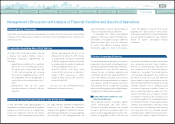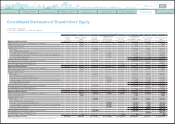Toyota 2012 Annual Report Download - page 70
Download and view the complete annual report
Please find page 70 of the 2012 Toyota annual report below. You can navigate through the pages in the report by either clicking on the pages listed below, or by using the keyword search tool below to find specific information within the annual report.
TOYOTA ANNUAL REPORT 2012
Toyota Global Vision Changes for Making
Ever-Better Cars President
ʼ
s Message Medium- to Long-Term
Growth Initiatives Special Feature Management and
Corporate Information Investor Information
Business and
Performance Review Financial Section
Management's Discussion and Analysis of Financial Condition and Results of Operations
long-term capital lease obligations with interest
rates ranging from 0.00% to 32.00%, and maturity
dates ranging from 2012 to 2050. The current
portion of long-term debt decreased during fiscal
2012 by ¥260.2 billion, or 9.4%, to ¥2,512.6 billion
and the non-current portion decreased by ¥406.9
billion, or 6.3%, to ¥6,042.2 billion. The decrease
in total borrowings resulted from a decrease in
bonds and medium-term notes, partially offset by
an increase in commercial paper. As of March 31,
2012, approximately 34% of long-term debt was
denominated in U.S. dollars, 26% in Japanese
yen, 11% in Australia dollars, and 29% in other
currencies. Toyota hedges interest rate risk
exposure of fixed-rate borrowings by entering
into interest rate swaps. There are no material
seasonal variations in Toyota
ʼ
s borrowings
requirements.
As of March 31, 2012, Toyota
ʼ
s total interest
bearing debt was 113.8% of Toyota Motor
Corporation shareholders
ʼ
equity, compared with
120.0% as of March 31, 2011.
The following table provides information for
credit rating of Toyota
ʼ
s short-term borrowing and
long-term debt from rating agencies, Standard
& Poor
ʼ
s Ratings Group
(
S&P
)
, Moody
ʼ
s Investors
Services
(
Moody
ʼ
s
)
, and Rating and Investment
Information, Inc.
(
R&I
)
, as of May 31, 2012. A credit
rating is not a recommendation to buy, sell or
hold securities. A credit rating may be subject to
withdrawal or revision at any time. Each rating
should be evaluated separately of any other rating.
its high credit ratings, it will continue to be able
to access funds from external sources in large
amounts and at relatively low costs. Toyota
ʼ
s ability
to maintain its high credit ratings is subject to a
number of factors, some of which are not within Toyota
ʼ
s unfunded pension liabilities
increased during fiscal 2012 by ¥130.8 billion, or
24.0%, to ¥676.6 billion. The unfunded pension
liabilities relate to the parent company and its
Japanese subsidiaries. The unfunded amounts
will be funded through future cash contributions
by Toyota or in some cases will be settled on the
retirement date of each covered employee. The
unfunded pension liabilities increased in fiscal
2012 compared with the prior fiscal year due to an
increase in pension benefit obligations resulted
from a decrease in discount rate. See note 19 to
the consolidated financial statements for further
discussion.
Toyota
ʼ
s treasury policy is to maintain
controls on all exposures, to adhere to stringent
counterparty credit standards, and to actively
monitor marketplace exposures. Toyota remains
centralized, and is pursuing global efficiency of
its financial services operations through Toyota
Financial Services Corporation.
The key element of Toyota
ʼ
s financial strategy
is maintaining a strong financial position that will
allow Toyota to fund its research and development
initiatives, capital expenditures and financial
services operations efficiently even if earnings
are subject to short-term fluctuations. Toyota
believes that it maintains sufficient liquidity for
its present requirements and that by maintaining
Toyota
ʼ
s control. These factors include general
economic conditions in Japan and the other
major markets in which Toyota does business, as
well as Toyota
ʼ
s successful implementation of its
business strategy.
S&P Moody
ʼ
s R&I
Short-term borrowing A
-
1+ P
-
1
—
Long-term debt AA
-
Aa3 AA+
Toyota uses its securitization program as part of
its funding through special purpose entities for its
financial services operations. Toyota is considered
the primary beneficiary of these special purpose
Toyota
ʼ
s financial services operations issue credit
cards to customers. As customary for credit card
businesses, Toyota maintains credit facilities with
holders of credit cards issued by Toyota. These
facilities are used upon each holder
ʼ
s requests up
to the limits established on an individual holder
ʼ
s
basis. Although loans made to customers through
these facilities are not secured, for the purposes
of minimizing credit risks and of appropriately
establishing credit limits for each individual
credit card holder, Toyota employs its own risk
management policy which includes an analysis
of information provided by financial institutions in
alliance with Toyota. Toyota periodically reviews
and revises, as appropriate, these credit limits.
entities and therefore consolidates them. Toyota
has not entered into any off-balance sheet
securitization transactions during fiscal 2012.
Outstanding credit facilities with credit card
holders were ¥256.2 billion as of March 31, 2012.
Toyota
ʼ
s financial services operations maintain
credit facilities with dealers. These credit
facilities may be used for business acquisitions,
facilities refurbishment, real estate purchases,
and working capital requirements. These loans
are typically collateralized with liens on real
estate, vehicle inventory, and/or other dealership
assets, as appropriate. Toyota obtains a personal
guarantee from the dealer or corporate guarantee
from the dealership when deemed prudent.
Although the loans are typically collateralized
or guaranteed, the value of the underlying
Off-Balance Sheet Arrangements
Lending Commitments
■
Credit Facilities with Credit Card Holders
■
Credit Facilities with Dealers
0820
Search NextPrev page 70
Contents
























